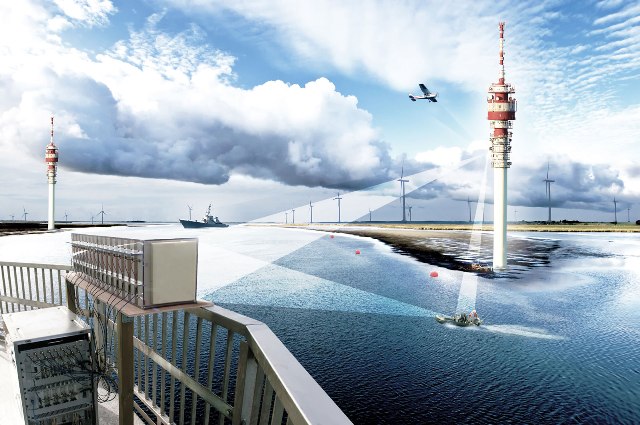Dec 1 2014
Many coastal areas and harbors go almost unprotected against acts of terror. Soon a new sensor system relying on signal echoes from cell towers can quickly detect even the smallest of attack boats. This mobile radio passive radar can also help airplanes avoid colliding with wind turbines.
 The PCL system also detects the motion of moving boats. (© Fraunhofer FKIE)
The PCL system also detects the motion of moving boats. (© Fraunhofer FKIE)
Airports are now subject to careful security surveillance, but many coastal towns and ports are not; they often lack radar installations to keep track of small boats, meaning terrorists could easily use speedboats to approach the coastline and bring explosives on land. Now, researchers at the Fraunhofer Institute for Communication, Information Processing and Ergonomics FKIE in Bonn developed a passive surveillance system for littoral regions based on mobile radio illumination called Passive Coherent Location (PCL). It passively employs the continuous radio signals emitted by cell towers to detect suspicious boats, including those speedboats favored by pirates for approaching cargo ships. The fusion with electro-optical or infrared systems allows the classification of the different targets.
This new method works in much the same way as radar systems, which send electromagnetic signals toward an object and then collect the echo they return. Similarly, the PCL system detects boats based on reflected electromagnetic radiation from mobile networks. But it’s much more difficult to evaluate radio signals than radar. A radar antenna transmits its own well-defined signals into a limited area. Echoes can be easily interpreted. The new sensor makes use of mobile network radio signals coming from different directions and from different cell towers. It receives a chaotic echo mix from which objects have to be carefully extracted. “One challenge is that our sensor system tends to pick up the strong signals from the cell towers themselves,” says Reda Zemmari, project manager at the FKIE “The signal echoes reflected off the boats on the water are considerably weaker.”
Versatile, mobile system
As a result, the researchers had to develop algorithms to compensate for this shortcoming. Now the software can suppress the strong radio signals coming directly from the cell towers. “It’s handy that different cell towers use different frequencies,” Zemmari continues, “because this allows the software to better differentiate between the various signals and echoes. What’s more, the system can detect boats that are in motion based on their movement that causes a frequency shift. “Our system continuously checks whether it is correctly assigning signals and correctly interpreting the object’s movements,” says Zemmari. During tests off Eckernförde and Fehmarn, the researchers have already successfully tracked speedboats just a few meters in length from four kilometers away. “Our system can be transported on a small trailer, which means it can be deployed anywhere,” says Zemmari – provided there is sufficient mobile network coverage. The research scientist emphasizes that the PCL system doesn’t in any way read users’ mobile data. “All we use is the transmitter’s operating signal, which does not carry customers’ data packets.”
Preventing acts of terrorism is just one use for the technology. The researchers are currently working on a version for wind turbines. Tall turbine towers must be lit up at night with blinking lights to warn airplane and helicopter pilots. Unfortunately, the blinking bothers many people. Instead, wind turbines could be equipped with airplane detectors that switch the lights on only when a plane is approaching. Detectors that react to radio signals from airplanes already exist. “But we need a redundant system in case these break down – and PCL technology is well suited for that task,” says Zemmari.